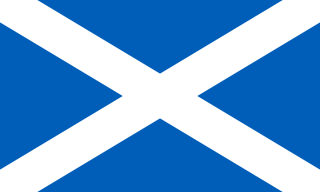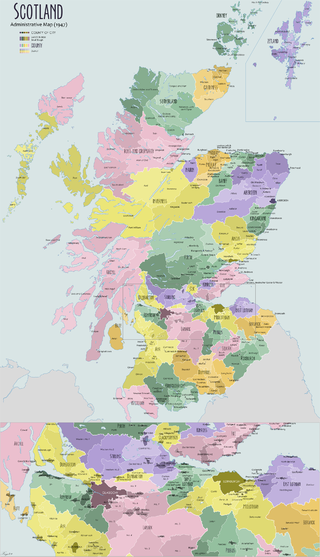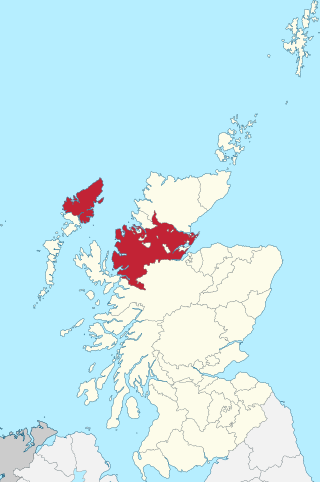
Cromartyshire was a county in the Highlands of Scotland, comprising the medieval "old shire" around the county town of Cromarty and 22 enclaves and exclaves transferred from Ross-shire in the late 17th century. The largest part, six times the size of the old shire, was Coigach, containing Ullapool and the area north-west of it. In 1889, Cromartyshire was merged with Ross-shire to become a new county called Ross and Cromarty, which in 1975 was merged into the new council area of Highland.

Local government in Scotland comprises thirty-two local authorities, commonly referred to as councils. Each council provides public services, including education, social care, waste management, libraries and planning. Councils receive the majority of their funding from the Scottish Government, but operate independently and are accountable to their local electorates. Councils raise additional income via the Council Tax, a locally variable domestic property tax, and Business rates, a non-domestic property tax.

The Shires of Scotland, or Counties of Scotland, were historic subdivisions of Scotland.

For local government purposes, Scotland is divided into 32 areas designated as "council areas", which are all governed by single-tier authorities designated as "councils". They have the option under the Local Government (Scotland) Act 1997 of being known as a "comhairle" when opting for a Gaelic name; only Comhairle nan Eilean Siar has chosen this option, whereas the Highland Council has adopted its Gaelic form alongside its English equivalent, informally.

Sutherland is a historic county, registration county and lieutenancy area in the Highlands of Scotland. The name dates from the Viking era when the area was ruled by the Jarl of Orkney; although Sutherland includes some of the northernmost land on the island of Great Britain, it was called Suðrland from the standpoint of Orkney and Caithness.

Ross and Cromarty, is an area in the Highlands and Islands of Scotland. In modern usage, it is a registration county and a lieutenancy area. Between 1889 and 1975 it was a county.

Caithness is a historic county, registration county and lieutenancy area of Scotland.

The County of Bute, also known as Buteshire, is a historic county and registration county of Scotland. Now replaced by Argyll and Bute for the Isle of Bute, with the Argyll and Bute Council. The Isle of Arran and the The Cumbraes are now in North Ayrshire Council area. Since the implimentation of the Local Government etc. (Scotland) Act 1994, on the 1 April 1996.

Selkirkshire or the County of Selkirk is a historic county and registration county of Scotland. It borders Peeblesshire to the west, Midlothian to the north, Roxburghshire to the east, and Dumfriesshire to the south. It derives its name from its county town, the royal burgh of Selkirk. The county was historically also known as Ettrick Forest.

A sheriff court is the principal local civil and criminal court in Scotland, with exclusive jurisdiction over all civil cases with a monetary value up to £100,000, and with the jurisdiction to hear any criminal case except treason, murder, and rape, which are in the exclusive jurisdiction of the High Court of Justiciary. Though the sheriff courts have concurrent jurisdiction with the High Court over armed robbery, drug trafficking, and sexual offences involving children, the vast majority of these cases are heard by the High Court. Each court serves a sheriff court district within one of the six sheriffdoms of Scotland. Each sheriff court is presided over by a sheriff, who is a legally qualified judge, and part of the judiciary of Scotland.

In Scotland a sheriff principal is a judge in charge of a sheriffdom with judicial, quasi-judicial, and administrative responsibilities. Sheriffs principal have been part of the judiciary of Scotland since the 11th century. Sheriffs principal were originally appointed by the monarch of Scotland, and evolved into a heritable jurisdiction before appointment was again vested in the Crown and the monarch of the United Kingdom following the passage of the Heritable Jurisdictions (Scotland) Act 1746.

The history of local government in Scotland is a complex tale of largely ancient and long established Scottish political units being replaced after the mid 20th century by a frequently changing series of different local government arrangements.

Ross-shire, or the County of Ross, was a county in the Scottish Highlands. It bordered Sutherland to the north and Inverness-shire to the south, as well as having a complex border with Cromartyshire, a county consisting of numerous enclaves or exclaves scattered throughout Ross-shire's territory. The mainland had a coast to the east onto the Moray Firth and a coast to the west onto the Minch. Ross-shire was named after and covered most of the ancient province of Ross, and also included the Isle of Lewis in the Outer Hebrides. The county town was Dingwall.
Ad vitam aut culpam is a condition of appointment or tenure, and the corresponding principle of appointment, and the corresponding type of appointment or form of tenure, in Scotland. Under the law of Scotland, an office is said to be held ad vitam aut culpam, when the tenure of the possessor is determinable only by his death or delinquency; or, in other words, which is held quamdiu se bene gesserit.

The Heritable Jurisdictions (Scotland) Act 1746 or the Sheriffs Act 1747 was an act of Parliament passed in the aftermath of the Jacobite rising of 1745 abolishing judicial rights held by Scots heritors. These were a significant source of power, especially for clan chiefs since it gave them a large measure of control over their tenants.
In the Courts of Scotland, a sheriff-substitute was the historical name for the judges who sit in the local sheriff courts under the direction of the sheriffs principal; from 1971 the sheriffs substitute were renamed simply as sheriff. When researching the history of the sheriffs and sheriffs principal of Scotland there is much confusion over the use of different names to refer to sheriffs in Scotland. Sheriffs principal are those sheriffs who have held office over a sheriffdom, whether through inheritance or through direct appointment by the Crown. Thus, hereditary sheriff and sheriff-depute are the precursors to the modern office of sheriff principal.

The judiciary of Scotland are the judicial office holders who sit in the courts of Scotland and make decisions in both civil and criminal cases. Judges make sure that cases and verdicts are within the parameters set by Scots law, and they must hand down appropriate judgments and sentences. Judicial independence is guaranteed in law, with a legal duty on Scottish Ministers, the Lord Advocate and the Members of the Scottish Parliament to uphold judicial independence, and barring them from influencing the judges through any form of special access.
A sheriffdom is a judicial district of Scotland. Originally identical to the Shires of Scotland, from the eighteenth century many counties were grouped to form "sheriffdoms".
The Sheriff of the Lothians and Peebles was historically the office responsible for enforcing law and order and bringing criminals to justice in The Lothians and Peebles, Scotland. Prior to 1748 most sheriffdoms were held on a hereditary basis. From that date, following the Jacobite uprising of 1745, the hereditary sheriffs were replaced by salaried sheriff-deputes, qualified advocates who were members of the Scottish Bar.
The Sheriff of Caithness was historically the royal official responsible for enforcing law and order in Caithness, Scotland.












